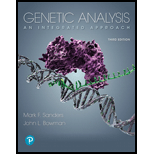
Concept explainers
To analyze:
Assume that the phylogenetic assignment of Plasmodium falciparum, the malarial
Introduction:
In the phylogenetic tree, species of interest are shown at the tips of the branches of the phylogenetic tree. The divergence of a single group into two descendant groups is shown at the branch point. The most recent common ancestors are found at each branch point. When two species have more related common ancestors, these species are more related, whereas when two species have less related common ancestors, these species are less related.
Non-photosynthetic early branching eukaryotic organisms do not have mitochondria as well as chloroplast. This suggests that mitochondria and chloroplast could have appeared in the eukaryotic cells at later evolutionary stages. One of the evolutionary models, endosymbiotic theory, suggests that prokaryotic endosymbionts are converted to a cell organelle. During eukaryotic evolution, heterotrophic eukaryotic cells engulf a photosynthetic eukaryotic cell that survives in symbiosis inside the heterotrophic cell from primary endosymbiosis.
Want to see the full answer?
Check out a sample textbook solution
Chapter 17 Solutions
Pearson eText Genetic Analysis: An Integrated Approach -- Instant Access (Pearson+)
- 4.1 Attine ants cultivate a garden of Leucocoprini fungus for its nourishment, while the fungus receives all its requirements for growth from the ants. The ants also promote the growth of an actinomycete, Pseudonocardia, which produces an antimicrobial compound that inhibits the growth of another fungus, Escovopsis which is a parasite of Leucocoprini. Check all the applicable interactions observed in this multi-species interaction from the choices givenarrow_forwardCASE #2 A 25-year-old Peace Corps worker has just returned from service in Ethiopia. She experiences a sudden onset of asthma-like symptoms. She has no previous history of asthma. An O & P (ova and parasites) on her stool was part of the normal discharge physical, considering the area of assignment, before being released from the Peace Corps. The sample was processed according to standard laboratory procedures. Two suspicious structures were noted during the direct saline wet preparation. The first of the two structures is noted in form # 1; it measures 50 x 40 um. The second structure is depicted in form #2 and measures 18 um in diameter. Form 1 Form 2 1. Which of the structures is (are) considered a pathogenic parasite(s)? Do the presenting symptoms relate to the O & P findings? If so, explain. Look at the structure depicted in form #1. What key characteristics allow you to identify the organism? Name the organism and its stage. 2. 3.arrow_forwardIn 1971, Dr. Akira Endo, working at the Sankyo company in Tokyo speculated that fungi not only contained antibiotics but also inhibitors of other processes such as cholesterol metabolism. Over a period of several years, he screened more than 6,000 fungal cultures until a positive result emerged. This compound, which was named compactin, came from the blue-green mold Penicillium citrinum Pen-5 that was isolated from a rice sample collected at a grain shop in Kyoto. Based on biochemical assays, compactin is the first known statin. 1. The original kinetics data for compactin inhibition of HMG-CoA reductase enzyme that was published by Dr. Endo in 1976 is shown on the right. a) Determine the Km and Vmax values for enzymatic activity. Do NOT forget the units. Answers can be expressed either as a fraction or in decimals. With No inhibitor: ; Vmax= -60 1/V, (nanomoles/min)-1 0.4 0.35+ 0.3 0.25 0.2 0.15 0.1 0.05 -40 -20 0 + 24 nM compactin + 70 nM compactin None T 20 40 60 1/[HMG-CoA], (mM)-1…arrow_forward
- #9arrow_forwardwhy is evolutionarily advantages for most parasites to be monoecious ?arrow_forwardGive the rank of the following taxa. 1. Gasteromycetes 2. Mangifera 3. Homininae 4. Eubacteria 5. Ganoderminae 6. Cyperaceae 7. Bangiophycidae 8. Pongidae 9. Basidiomycetidae 10. Leucophiniarrow_forward
- Select all of the characteristics shared by Penicillium chrysogenum and Euplotes vannus. A) Both have linear chromosomes. B) Transcription occurs in the nucleus of both organisms. C) Both are prokaryotic organisms. D) Because both are unicellular, they use RNA as their genetic information. E) Translation occurs on ribosomes for both organisms.arrow_forwardWhich of the following would result to any changes of the micromeres in the sea urchin blastula e.g removal, transplantation etc.? Choose all possible answers a) formation of a secondary axis b) formation of a Dauerblastula c) Endoderm generated from the animal hemisphere d) Formation of filopodia e) Formation of a pluteus larva f) secondary archenteron formationarrow_forwardDescribe the Theory of Endosymbiosis. a) Briefly define the Endosymbiotic Theory. 2 pts,b) Explain why the Theory of Endosymbiosis is considered a “theory” and not a “hypothesis.” 3 pts,c) Provide a description of eukaryotic and prokaryotic cells, including at least 4 similarities and 4 structural differences. 4 pts,d) Describe the sequence of events with anaerobic ancestral proto-eukaryotes and aerobic prokaryotes that led to the formation of mitochondria and chloroplasts inside eukaryotic cells. (Be sure to define aerobic and anaerobic respiration.) 6 pts,e) Explain how each, the anaerobic ancestral proto-eukaryotes and aerobic prokaryotes, benefited from the relationship. 4 pts,f) Describe 7 pieces of evidence for this scientific theory. Some of this evidence will consist of a list of similarities between mitochondria characteristics and bacteria characteristics. Along with this list of similarities, explain HOW the characteristics are similar. 10 pts,g) The Endosymbiotic Theory…arrow_forward
- Enumerate examples and the molecular basis behind these diseases. give what is askarrow_forwardApicomplexans evolved from a photosynthetic ancestor and have the remnant of a chloroplast. This organelle no longer acts in photosynthesis, but remains essential to the protist. Why might targeting this organelle yield an antimalarial drug with minimal side effects in humans?arrow_forwardWhy is the term prokaryote considered an inadequate descriptor by some microbiologists?arrow_forward
 Biology: The Dynamic Science (MindTap Course List)BiologyISBN:9781305389892Author:Peter J. Russell, Paul E. Hertz, Beverly McMillanPublisher:Cengage Learning
Biology: The Dynamic Science (MindTap Course List)BiologyISBN:9781305389892Author:Peter J. Russell, Paul E. Hertz, Beverly McMillanPublisher:Cengage Learning


